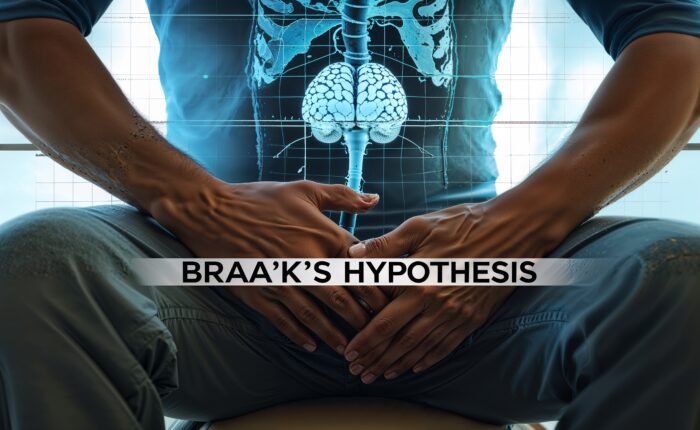Introduction: Rethinking Parkinson’s as a Multi-System Disorder

Parkinson’s disease (PD) is widely recognized for its hallmark motor symptoms—tremor, rigidity, and slowness of movement. However, a growing body of research is pushing beyond the traditional brain-centric view of Parkinson’s and revealing its true complexity: PD is not just a neurological disorder. It’s a multi-organ, multi-system condition that interacts dynamically with the gut, immune system, and other physiological systems.
In this post, we dive deep into how the latest research shifts our understanding of PD through the lens of multi-organ axis theory, highlighting the critical importance of gut-brain connections, microbiome health, and systemic inflammation.
Step One: Parkinson’s Disease Basics
Parkinson’s disease is a progressive neurodegenerative disorder caused by the loss of dopamine-producing neurons, primarily in the substantia nigra region of the brain. This dopamine deficit leads to the motor symptoms most people associate with PD.
Yet motor symptoms are just the tip of the iceberg. Non-motor symptoms—like constipation, mood disorders, fatigue, and sleep disturbances—can begin decades earlier. These symptoms often go unrecognized, even though they hold crucial clues to early diagnosis.
The motor and non-motor dichotomy has prompted scientists to explore PD beyond the brain. New perspectives increasingly support the idea that PD symptoms might start outside the central nervous system—particularly in the gut.
Step Two: The Gut-Brain Axis and Braak’s Hypothesis
The gut-brain axis refers to the bidirectional communication between the gut and the brain, orchestrated through neural (vagus nerve), immune, and endocrine signaling.
In PD, Braak’s Hypothesis proposes that abnormal clumps of a protein called alpha-synuclein may begin in the gut’s enteric nervous system and spread to the brain via the vagus nerve. Evidence supporting this includes:
- Alpha-synuclein deposits in gut tissues of PD patients, even before motor symptoms appear.
- Animal studies showing gut-originated alpha-synuclein traveling along the vagus nerve to reach the brain.
- Clinical data correlating vagotomy (severing the vagus nerve) with reduced PD risk.
This “bottom-up” model of neurodegeneration represents a seismic shift in how PD is conceptualized, diagnosed, and treated.
Step Three: Gut Microbiota and Systemic Inflammation
The gut is home to trillions of microorganisms, collectively known as the gut microbiota. In PD, studies show a clear pattern of dysbiosis—an imbalance in gut bacteria. This microbial shift is associated with:
- Increased intestinal permeability (“leaky gut”).
- Entry of bacterial endotoxins into the bloodstream.
- Chronic systemic inflammation, which contributes to neuroinflammation and degeneration in brain tissue.
Certain bacterial strains in the gut can also impact neurotransmitter production, immune response, and even behavior. The cascade from microbial changes to inflammation to brain changes is a compelling thread tying the gut to Parkinson’s pathology.
Step Four: Beyond the Gut – A Multi-Organ Approach
While the gut-brain axis is the most studied, Parkinson’s may also involve other organ systems, such as:
- Immune System: Chronic inflammation seen in PD may result from immune overactivation triggered by peripheral or central factors.
- Cardiovascular System: PD patients frequently experience orthostatic hypotension (a drop in blood pressure when standing), pointing to broader autonomic dysfunction.
- Liver and Kidney: These organs may influence drug metabolism and toxin clearance, affecting PD progression and treatment efficacy.
Such findings support viewing PD as a multi-organ axis disorder—where dysfunction in one system can exacerbate or mask symptoms in another.
Step Five: Implications for Diagnosis and Treatment
This broader framework leads to earlier and more personalized interventions. Here’s how:
1. Early Detection:
- GI symptoms like constipation, bloating, and nausea may signal prodromal PD.
- Measuring alpha-synuclein in gut biopsies or stool samples could become part of future diagnostics.
2. Microbiota-Targeted Therapies:
- Probiotics, prebiotics, and dietary changes are under investigation for their potential to re-balance gut flora and reduce inflammation.
- Fecal microbiota transplantation (FMT) is also being explored as a radical therapeutic option.
3. Multi-Organ Biomarkers:
- Instead of relying solely on brain imaging or clinical symptoms, researchers are investigating multi-organ biomarkers, including those from the liver, kidney, and immune system.
4. Precision Medicine:
- The integration of data across organs, systems, and individual microbiomes may lead to personalized PD care plans that adapt dynamically to a patient’s evolving symptom profile.
Step Six: The Future of Multi-Axis Research in PD
Cutting-edge technologies are being developed to model the disease across organs:
- Organ-on-a-chip models allow researchers to simulate interactions between the brain and gut or immune system in controlled settings.
- Wearable health monitors and AI-driven symptom tracking help gather continuous data across organ systems and detect subtle changes in behavior or biology.
- Digital biomarkers, derived from smartphone apps and sensors, may one day give real-time insights into the functional status of both central and peripheral systems.
These innovations hold enormous promise for slowing disease progression, enhancing quality of life, and tailoring care for every person living with PD.
Final Thoughts: Parkinson’s as a Networked Disease
As researchers explore the multi-organ landscape of Parkinson’s disease, we’re learning that no symptom exists in isolation. The brain is not a disconnected control center—it’s a deeply interconnected node in a broader biological web. The path forward is not just neurological but systemic, microbial, and molecular.
By embracing this complexity, we move closer to precision diagnosis, holistic care, and eventually, disease modification and prevention.
AI-generated medical infographics on Parkinson’s symptoms, treatment advances, and research findings; I hope you found this blog post informative and interesting. www.parkiesunite.com by Parkie
Generative AI Prompt for Image:
“A photo-realistic image showing a middle-aged person seated calmly with one hand on their abdomen and the other gently resting on a medical chart displaying the gut-brain axis. Background includes faint outlines of brain scans, alpha-synuclein molecules, and intestinal lining. Natural light, scientific but warm setting. 720×1080, 16:9.”
Taglines (20 characters each):
- Beyond Brain Symptoms
- Gut Clues to Parkinson’s
- Multi-Axis PD Research
Negative Prompt:
“Malformed limbs, extra limbs, mutated hands, disfigured face, bad anatomy, malformed hands, Text, lettering, captions, generating images with text overlays”
SEO Keywords (Post Ending):
Parkinson’s disease, gut-brain axis, alpha-synuclein, systemic inflammation, neurodegeneration